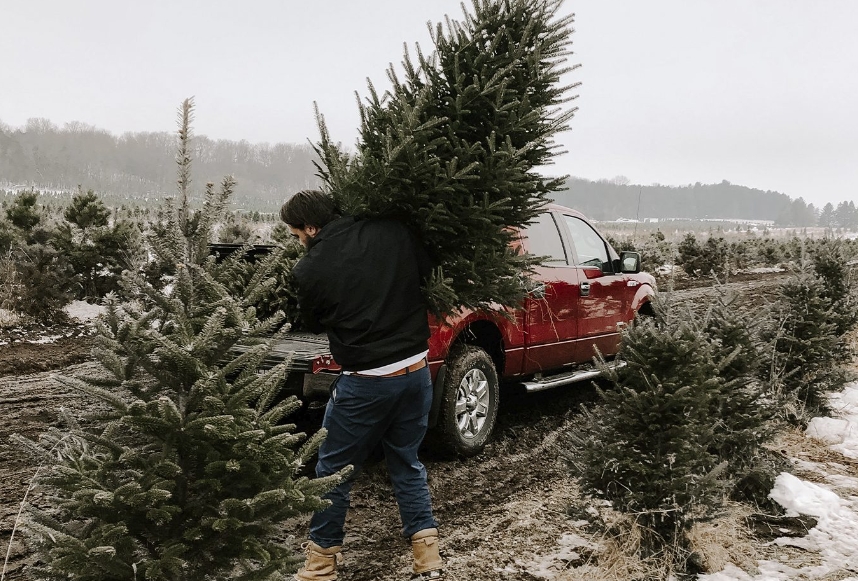The answer may not be as simple as you think. The debate about choosing a real or artificial Christmas tree has been raging for years. Fresh trees smell great but can also be contaminated with various pesticides and metals; artificial trees are less of a hassle, but require year-round storage. But there is another, more important point: which type of spruce is a more climate-resilient option? To understand the essence of the issue, we have collected the latest data on this.
Pros and Cons of an artificial Christmas tree
Reusing the same artificial Christmas tree year after year sounds greener, but it’s important to consider the climate impact of plastic tree production and logistics around the world.
It turns out that the industry of artificial Christmas trees is very large. Statistics Canada reports that in 2017, the total value of artificial trees imported into Canada was $60.8 million, with 97 percent of those trees coming from China.
Most artificial Christmas trees are made from PVC, which is one of the worst plastics mankind can produce. Emissions are generated during production, delivery to stores and at home – huge masses of carbon footprint are associated with this product.
And then there’s what happens to your fake tree when you decide to throw it away. Artificial Christmas trees are made from plastic and metal and cannot be recycled. Therefore, they tend to end up in landfills, where they can take hundreds of years to decompose.
A comparative study of the life cycle of artificial and natural trees, published in 2009 by Montreal-based consulting firm Ellipsos, found that the total carbon dioxide emissions over the life cycle of an artificial Christmas tree is 8.1 kg of CO2 per year, or 48.3 kg per year. her entire life cycle, which she measured at six years old. In comparison, a real Christmas tree emitted 3.1 kg of CO2 in one year (so if you bought a real Christmas tree for six years in a row, the total amount of CO2 would be 18.6 kg).
One factor that makes a big difference is how many years you can reuse your artificial Christmas tree. If you do this for decades, then you reduce the impact that artificial beauty has on the climate. Your tree has outlived its carbon footprint many times over. However, this approach is only a rare exception. Artificial trees last approximately 6 to 10 years. However, the lifespan depends on the quality of the wood, as well as factors such as how well you take care of it (protect it from sunlight, clean and store it properly) and whether it has backlighting (which may eventually stop working). In general, the longer you use your faux tree, the better – the Ellipsos study notes that to minimize the impact of a faux tree, you’ll need to use it for 20 years or more.

Pros and Сons of a real Christmas tree
When you go to a Christmas tree farm, it takes many years for that tree to grow big enough to be purchased, and as it grows, it benefits people and nature.
Some of these benefits include carbon uptake and oxygen release. How much carbon a Christmas tree actually absorbs depends on a number of factors, such as the type of soil, the type of tree, and its age. It is estimated that one acre of Christmas trees provides enough oxygen for 18 people daily and also provides habitat for birds and small animals.
Part of what makes a real tree a sustainable option also has to do with how the tree farm itself is managed. There are many Christmas tree farms that have programs where for every tree they cut down, they plant two or three more trees to replace it. So overall you get the net benefit of using natural Christmas trees.
It’s also worth noting that buying a real Christmas tree from a store near you supports the local economy. Perhaps the biggest benefit of real Christmas trees is the fact that they are biodegradable, so at the end of their life they don’t contribute to landfill pollution – unless you dispose of them properly, of course.
But just like fake trees, there is one factor that greatly affects how sustainable a real tree is: how far you travel to acquire a tree. When calculating CO2 in the Ellipsos study for real and artificial trees, consumers traveled about five kilometers to purchase their trees. The more distance you travel to pick up a real tree, the greater your total emissions will be. The same can be said about real trees that are sold in stores near you, but which were grown hundreds of kilometers away.
The shorter the distance a tree has to travel, the smaller its carbon footprint. If trees are transported long distances, transport emissions can mitigate any real difference between having a real tree or a fake tree. So, the more local the choice is, the better.

How do I get rid of my artificial Christmas tree?
As already noted, artificial trees are not recyclable and often end up in landfills. Take good care of your artificial tree so that it lasts as long as possible. If it’s still in reasonably good condition, consider donating it.
How can I get rid of the real tree?
Real trees are biodegradable and there are several options for how to properly dispose of them.
Some municipalities allow real trees to be composted as part of their composting or yard waste collection programs. Municipalities may also have special places to collect fir trees after the holidays.
There are also many organizations around the world, for example in Canada they collect Christmas trees for various types of restoration projects. For example, Trout Unlimited Canada annually collects trees for Ontario creek restoration projects, Credit Valley Conservation in Alton collects trees for river watershed restoration projects, and WILDNorth, a wildlife rescue and rehabilitation organization in Alberta, accepts Christmas trees that are then used in their enclosures.
Remember that it is important to properly dispose of your spruce, whether it is real or artificial. For example, many people may consider the simple act of simply taking their real spruce to the nearest forest and leaving it, but this approach can also disrupt the local ecosystem.

The last word in choosing real and artificial Christmas trees
If you can use an artificial Christmas tree for a few years – 20 years or more to be exact – it will reduce the environmental impact of the tree. Just remember that these trees cannot be recycled, they end up in a landfill at the end of their life anyway.
On the other hand, while real trees benefit the environment as they grow and are biodegradable at the end of their lives, it’s important to understand where you are and how far these trees are acquiring. There are also options for using real trees in pots and the ability to rent them. In any case, we note that the answer to this question is complex.
There are many reasons why someone might choose a real or artificial Christmas tree as part of their holiday tradition. We just want to make sure we don’t shame anyone for the choices they make and that they have the information they need when choosing a tree.

